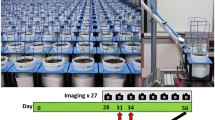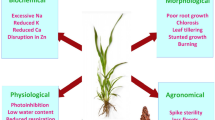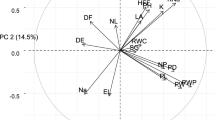Abstract
Main conclusion
Ten of 34 tested duckweed clones showed relatively higher salt tolerance. Salinity stress induced high level of starch accumulation in these clones, making them potential feedstock candidates for biofuel production.
Duckweeds are promising as a new generation of crop plants that requires minimal input while providing fast biomass production. Two important traits of interest that can impact on the economic viability of this system are their sensitivity to salt and the starch content of the harvested duckweed. We have surveyed 33 strains of duckweed selected from across all 5 genera and amongst 13 species to quantify the natural variance of these traits. We found that there are large ranges of intraspecific variations in salt tolerance, while all species examined accumulated more starch in response to the initial stages of salt stress. However, the magnitude of the change in starch content varied widely between strains. Our results suggest that specific duckweed clones can be cultivated under relatively saline conditions, while increasing salt in the medium before harvesting could be used to increase starch in duckweed biomass for bioethanol production.



Similar content being viewed by others
Abbreviations
- EC x :
-
Effect concentration for the inhibition of growth rate at the level of x % (x = 10, 20, 50)
- DW:
-
Dry weight
- RGR:
-
Relative growth rates
References
Anderson KE, Lowman Z, Stomp AM, Chang J (2011) Duckweed as a feed ingredient in laying hen diets and its effect on egg production and composition. Int J Poultry Sci 10:4–7
Appenroth K-J, Lam E (2012) Duckweed as crop plants. Biol Unserer Zeit 42:181–187
Appenroth K-J, Teller S, Horn M (1996) Photophysiology of turion formation and germination in Spirodela polyrhiza. Biol Plant 38:95–106
Appenroth K-J, Krech K, Keresztes Á, Fischer W, Koloczek H (2010) Effects of nickel on the chloroplasts of the duckweeds Spirodela polyrhiza and Lemna minor and their possible use in biomonitoring and phytoremediation. Chemosphere 78:216–223
Bergmann BA, Cheng J, Classen J, Stomp A-M (2000) In vitro selection of duckweed geographical isolates for potential use in swine lagoon effluent renovation. Bioresour Technol 73:13–20
Buckley JA, Rustagi KP, Laughlin JD (1996) Response of Lemna minor to sodium chloride and a statistical analysis of continuous measurements for EC50 and 95% confidence limits calculation. B Environ Contam Tox 57:1003–1008
Chang I-H, Cheng K-T, Huang P-C, Lin Y-Y, Cheng L-J, Cheng T-S (2012) Oxidative stress in greater duckweed (Spirodela polyrhiza) caused by long-term NaCl exposure. Acta Physiol Plant 34:1165–1176
Cheng T-S (2011) NaCl-induced responses in giant duckweed (Spirodela polyrhiza). J Aquat Plant Manag 49:62–71
Cheng T-S, Hunga M-J, Chenga Y-I, Cheng L-J (2013) Calcium-induced proline accumulation contributes to amelioration of NaCl injury and expression of glutamine synthetase in greater duckweed (Spirodela polyrhiza L.). Aquat Toxicol 144(145):265–274
Cui W, Cheng JJ (2015) Growing duckweed for biofuel production: a review. Plant Biol 17:16–23
Demirezen DY (2007) Effects of salinity on growth and nickel accumulation capacity of Lemna gibba (Lemnaceae). J Hazard Mater 147:74–77
Keppeler EC (2009) Toxicity of sodium chloride and methyl parathion on the macrophyte Lemna minor (Linnaeus, 1753) with respect to frond number and chlorophyll. Biotemas 22(3):27–33
Kuehdorf K, Jetschke G, Ballani L, Appenroth K-J (2014) The clonal dependence of turion formation in the duckweed Spirodela polyrhiza—an ecogeographical approach. Physiol Plant 150:46–54
Lam E, Appenroth K-J, Michael T, Mori K, Fakhoorian T (2014) Duckweed in bloom: the 2nd international conference on duckweed research and applications heralds the return of a plant model for plant biology. Plant Mol Biol 84:737–742
Landolt E (1986) The family of Lemnaceae—a monographic study. Veroeffentlichungen des Geobotanischen Institutes ETH, vol 1. Stiftung Ruebel, Zurich, Switzerland
Landolt E, Kandeler R (1987) The family of Lemnaceae—a monographic study. Veroeffentlichungen des Geobotanischen Institutes ETH, vol 2. Stiftung Ruebel, Zurich, Switzerland
Munns R, Tester M (2008) Mechanisms of salinity tolerance. Annu Rev Plant Biol 59:651–681
Naumann B, Eberius M, Appenroth K-J (2007) Growth rate based dose-response relationships and EC-values of ten heavy metals using the duckweed growth inhibition test (ISO 20079) with Lemna minor L. clone St. J Plant Physiol 164:1656–1664
Panda SK, Upadhyay RK (2003) Salt stress injury induces oxidative alterations and antioxidative defence in the roots of Lemna minor. Biol Plant 48:249–253
Radic S, Pevalek-Kozlina B (2010) Effects of osmotic stress on antioxidative system of duckweed (Lemna minor L). Period Biol 112:293–299
Schenk RU, Hildebrandt AC (1972) Medium and techniques for induction and growth of monocotyledonous and dicotyledonous plant cell cultures. Can J Bot 50:199–204
Sikorski L, Piotrowicz-Cieslak AI, Adomas B (2013) Phytotoxicity of sodium chloride towards common duckweed (Lemna minor L.) and yellow lupin (Lupinus luteus L.). Arch Environ Prot 39:117–128
Sree KS, Appenroth K-J (2014) Increase of starch accumulation in the duckweed Lemna minor under abiotic stress. Albanian J Agric Sci 13(special edition):11–14
Upadhyay RK, Panda SK (2004) Biochemical responses and oxidative stress induction in the roots of freshly grown Spirodela polyrhiza L. exposed to different levels of salinity. Isr J Plant Sci 52:189–193
Wang G, Chen L, Hao Z, Li X, Liu Y (2011) Effects of salinity stress on the photosynthesis of Wolffia arrhiza as probed by the OJIP test. Fresenius Environ Bull 20:432–438
Xiao Y, Fang Y, Jin Y, Zhang G, Zhao H (2013) Culturing duckweed in the field for starch accumulation. Ind Crop Prod 48:183–190
Xu J, Cui W, Cheng JJ, Stomp A-M (2011) Production of high-starch duckweed and its conversion to bioethanol. Biosyst Eng 110:67–72
Xu J, Cui W, Cheng JJ, Stomp A-M (2012) Growing Spirodela polyrrhiza in swine wastewater for the production of animal feed and fuel ethanol: a pilot study. Clean - Soil Air Water 40:760–765
Yang L, Han H, Liu M, Zuo Z, Zhou K, Lu J, Zhu Y, Bai Y, Wang Y (2013) Overexpression of the Arabidopsis photorespiratory pathway gene, serine: glyoxylate aminotransferase (AtAGT1), leads to salt stress tolerance in transgenic duckweed (Lemna minor). Plant Cell Tiss Org 113:407–416
Zhao H, Appenroth K, Landesman L, Salmean AA, Lam E (2012) Duckweed rising at Chengdu: summary of the 1st international conference on duckweed application and research. Plant Mol Biol 78:627–632
Zhao Y, Fang Y, Jin Y, Huang J, Bao S, Fu T, He Z, Wang F, Wang M, Zhao H (2015) Pilot-scale comparison of four duckweed strains from different genera for potential application in nutrient recovery from wastewater and valuable biomass production. Plant Biol 17:82–90
Ziegler P, Adelman K, Zimmer S, Schmidt C, Appenroth K-J (2015) Relative in vitro growth rates of duckweeds (Lemnaceae)—the most rapidly growing higher plants. Plant Biol 17:33–41
Acknowledgments
We thank Prof. em. Dr. Elias Landolt (died on 1. 4. 2013) for the discussion on suitable clones for the present study, and Mr. Robert Bell from Australia for providing the starting material for clone no. 9637 (Landoltia punctata). We also acknowledge the support of Ms. Sabrina Zimmer and Mr. Christoph Schmidt. Research on duckweed in the Lam lab is supported in part by the New Jersey Agricultural Experiment Station (Hatch project #12116) and the School of Environmental and Biological Sciences. CG was supported in part by a Research Assistant fellowship by the Aresty Research Center at Rutgers University. KSS acknowledges the support from Science and Engineering Research Board, Government of India through Fast Track Young Scientist project.
Author information
Authors and Affiliations
Corresponding author
Electronic supplementary material
Below is the link to the electronic supplementary material.
425_2015_2264_MOESM1_ESM.xlsx
Supplementary material Table S1 Inhibition parameters for duckweed clones under the influence of NaCl. Effective concentration for the inhibition of the growth (EC x ) was calculated on the basis of dry weight for the inhibition levels of 10, 20 and 50 % (EC10, EC20, EC50) for the test period of 7 days according to the ISO20079 protocol. The intervals of confidence (95 % level) are given in brackets (XLSX 17 kb)
Rights and permissions
About this article
Cite this article
Sree, K.S., Adelmann, K., Garcia, C. et al. Natural variance in salt tolerance and induction of starch accumulation in duckweeds. Planta 241, 1395–1404 (2015). https://doi.org/10.1007/s00425-015-2264-x
Received:
Accepted:
Published:
Issue Date:
DOI: https://doi.org/10.1007/s00425-015-2264-x




